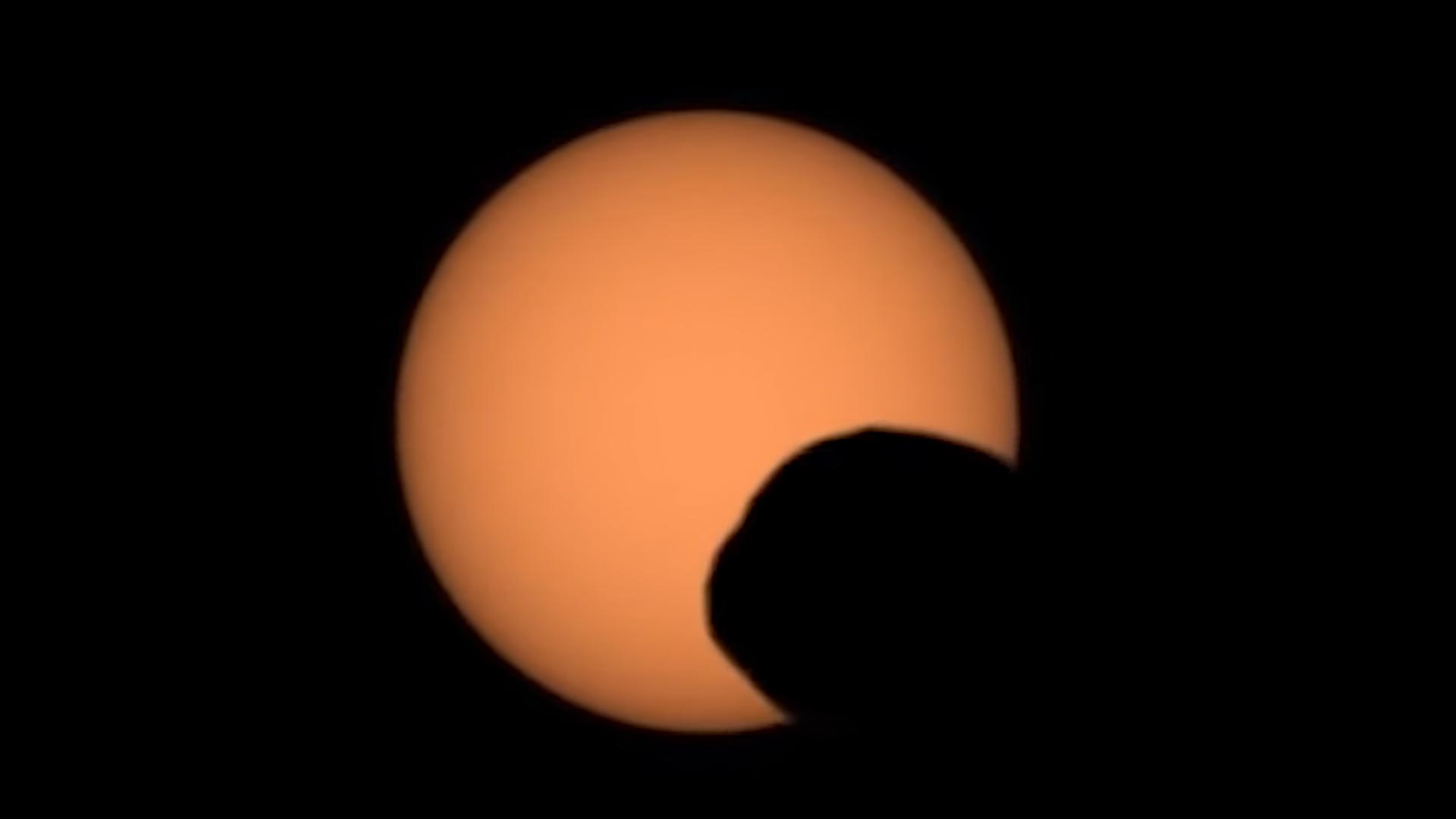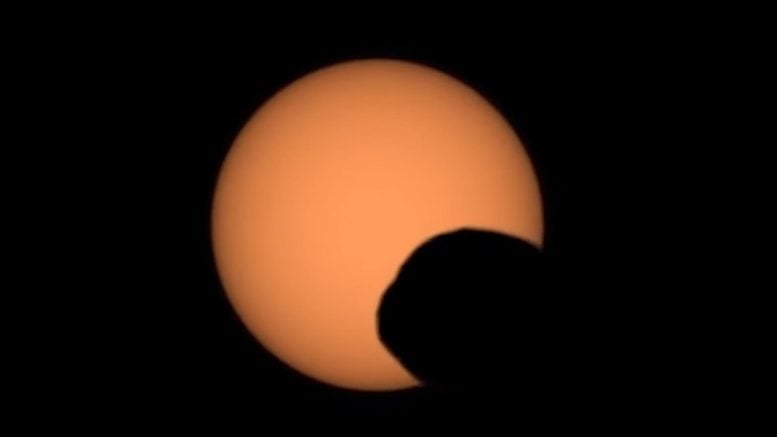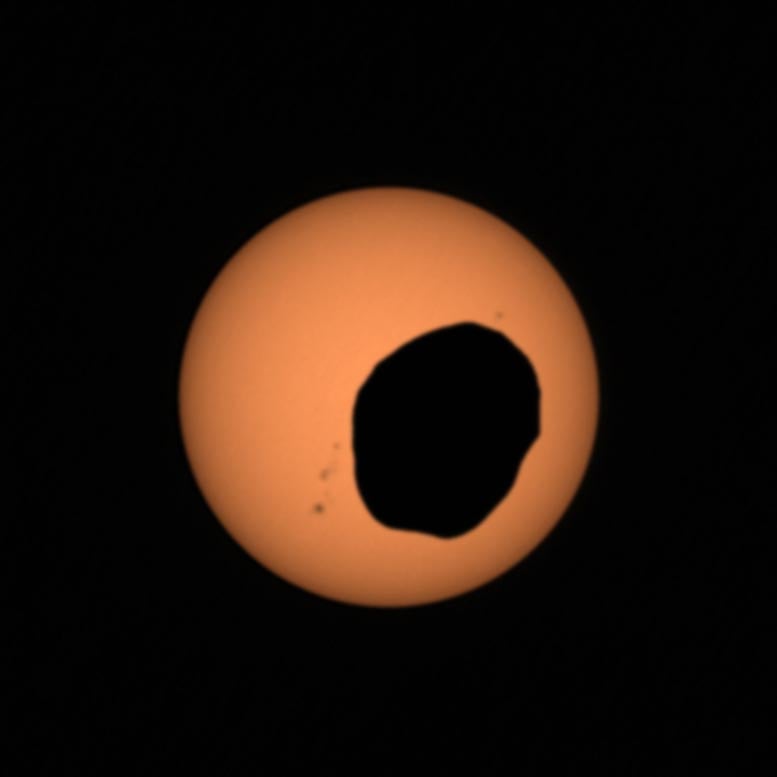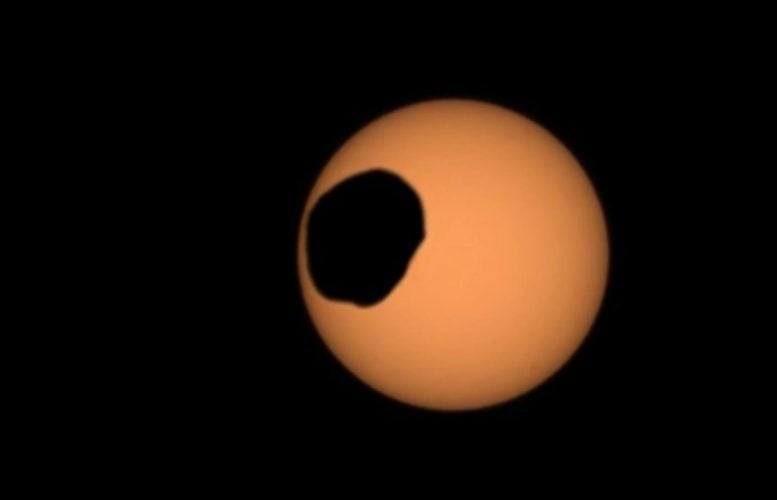

NASA’s Perseverance rover captured an intriguing astronomical event from Mars’ Jezero Crater: a transit of the Martian moon Phobos across the Sun.
This rare event, resembling a “googly eye,” revealed not only the celestial dynamics of Mars’ moons but also offered insights into their orbit and future.
Unusual Celestial Event Captured by Perseverance Rover
From its vantage point on the western wall of Mars’ Jezero Crater, NASA’s Perseverance rover recently captured an unusual sight resembling a “googly eye” peering down from space. In this cosmic view, the “pupil” is Mars’ moon Phobos, while the “iris” is our Sun.
On September 30, during the 1,285th Martian day of Perseverance’s mission, the rover’s Mastcam-Z captured Phobos—a potato-shaped moon—as it passed directly between the Sun and Mars, partially obscuring the Sun’s disc. As Phobos appeared as a large black circle swiftly crossing the Sun, its shadow, known as the antumbra, moved across Mars’ surface.
NASA’s Perseverance Mars rover used its Mastcam-Z camera to capture the silhouette of Phobos, one of the two Martian moons, as it passed in front of the Sun on September 30, 2024, the 1,285th Martian day, or sol, of the mission. Perseverance has captured several Phobos transits since its landing at Mars’ Jezero Crater in February 2021. The video shows the transit speeded up by four times, followed by the eclipse in real time. Credit: NASA/JPL-Caltech/ASU/MSSS
Historical and Astronomical Significance of Phobos
Phobos was named in 1877 by astronomer Asaph Hall after the Greek god of fear and panic. (The word “phobia” comes from Phobos. And the word for fear of potatoes, and perhaps potato-shaped moons, is potnonomicaphobia.) Hall also named Mars’ second moon, Deimos, after Phobos’ mythological twin. Phobos, about 17 miles (27 kilometers) across at its widest, is roughly 157 times smaller than Earth’s Moon, and Deimos is even smaller.
Roughly 157 times smaller in diameter than Earth’s Moon, Phobos is only about 17 miles (27 kilometers) at its widest point. Deimos is even smaller.

Observing the Skies of Mars
Because Phobos’ orbit is almost perfectly in line with the Martian equator and relatively close to the planet’s surface, transits of the moon occur on most days of the Martian year. Due to its quick orbit (about 7.6 hours to do a full loop around Mars), a transit of Phobos usually lasts only 30 seconds or so.
This is not the first time that a NASA rover has witnessed Phobos blocking the Sun’s rays. Perseverance has captured several Phobos transits (see images above and below) since landing at Mars’ Jezero Crater in February 2021. Curiosity captured a video in 2019. And Opportunity captured an image in 2004.
By comparing the various images, scientists can refine their understanding of the moon’s orbit to learn how it’s changing. Phobos is getting closer to Mars and is predicted to collide with it in about 50 million years.

Perseverance’s Mission Objectives and Collaborations
The Mars 2020 Perseverance rover, managed by NASA’s Jet Propulsion Laboratory in California, is a pioneering mission focused on astrobiology and Mars exploration. A core goal of Perseverance is to search for signs of ancient microbial life on Mars, providing insights into the planet’s geological history and climate. This mission marks the first attempt to collect and cache Martian rock and regolith, with future NASA and ESA missions planned to retrieve these samples and return them to Earth for detailed study.
The rover is equipped with advanced scientific tools, including the Mastcam-Z camera system, operated by Arizona State University in collaboration with Malin Space Science Systems and the Niels Bohr Institute. This camera system aids in capturing high-resolution imagery and supporting the mission’s geological studies. Perseverance is part of NASA’s broader Moon to Mars exploration strategy, where Artemis missions to the Moon will help lay the groundwork for eventual human exploration of Mars.